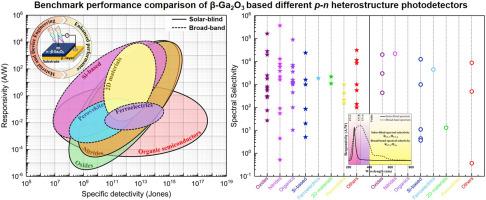From Materials to Device Engineering: Unravelling the Path to High Performance β-Ga2O3 based p-n Heterostructure Photodetectors
IF 9.7
2区 材料科学
Q1 MATERIALS SCIENCE, MULTIDISCIPLINARY
引用次数: 0
Abstract
The wide bandgap oxide semiconductor β-Ga2O3 with intrinsic solar-blind spectral selectivity and ability to operate in extreme harsh conditions makes it a go-to material for the design of future low-powered miniaturized photodetectors. The review comprehensively discusses the integration of β-Ga2O3 with different p-type class of materials (oxides, nitrides, organics, silicon-based, ferroelectric, two-dimensional semiconductors, perovskites and others) to realize p-n heterojunction; that offers built-in electric field which helps in light induced charge separation and promote charge collection efficiency. The review categorically discusses the challenges and critical role played by crystallinity, lattice mismatch, and band alignments for β-Ga2O3 based different p-n heterostructures. The review outlines different interface and nanostructure engineering techniques used to mitigate lattice mismatch effects and tailor the band-alignments at the interface of β-Ga2O3/p-layers to yield optimum photodetection. Then, application of myriad surface, dopant, contact, and heterojunction engineering techniques towards β-Ga2O3 based different p-n heterostructures for efficient light induced charge carrier generation, separation, transport, extraction and collection is discussed. The review outlines and compares for the first time, the current state-of-art diverse class of β-Ga2O3 based p-n heterostructure photodetectors in terms of their responsivity, detectivity and spectral selectivity; and advocates for future synergistical engineering approaches to unravel their true potential.

从材料到器件工程:揭示高性能β-Ga2O3基p-n异质结构光电探测器的路径
宽禁带氧化物半导体β-Ga2O3具有固有的太阳盲光谱选择性和在极端恶劣条件下工作的能力,使其成为设计未来低功耗小型化光电探测器的首选材料。本文全面讨论了β-Ga2O3与不同p型材料(氧化物、氮化物、有机物、硅基、铁电、二维半导体、钙钛矿等)的集成,实现p-n异质结;它提供了内置电场,有助于光诱导电荷分离和提高电荷收集效率。本文分类讨论了结晶度、晶格错配和能带对准对β-Ga2O3基不同p-n异质结构的挑战和关键作用。本文概述了不同的界面和纳米结构工程技术,用于减轻晶格错配效应和定制β-Ga2O3/p层界面的能带对准,以获得最佳的光探测。然后,讨论了各种表面、掺杂、接触和异质结工程技术在基于β-Ga2O3的不同p-n异质结构中的应用,以实现高效的光诱导载流子的产生、分离、传输、提取和收集。本文从响应性、检出率和光谱选择性等方面,首次对目前先进的各类β-Ga2O3基p-n异质结构光电探测器进行了概述和比较;并提倡未来的协同工程方法,以揭示其真正的潜力。
本文章由计算机程序翻译,如有差异,请以英文原文为准。
求助全文
约1分钟内获得全文
求助全文
来源期刊

Materials Today Physics
Materials Science-General Materials Science
CiteScore
14.00
自引率
7.80%
发文量
284
审稿时长
15 days
期刊介绍:
Materials Today Physics is a multi-disciplinary journal focused on the physics of materials, encompassing both the physical properties and materials synthesis. Operating at the interface of physics and materials science, this journal covers one of the largest and most dynamic fields within physical science. The forefront research in materials physics is driving advancements in new materials, uncovering new physics, and fostering novel applications at an unprecedented pace.
 求助内容:
求助内容: 应助结果提醒方式:
应助结果提醒方式:


